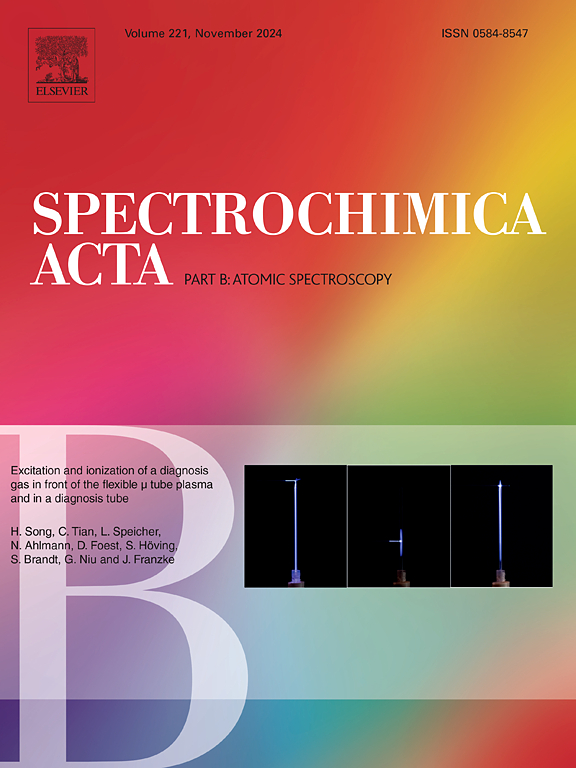Impact of soldering temperatures on heavy metal and dust emissions: A LIBS-based environmental pollution analysis
IF 3.2
2区 化学
Q1 SPECTROSCOPY
引用次数: 0
Abstract
Soldering is a critical operation in various industrial sectors, however, the pollution generated by this process is emerging as a significant environmental concern. This study utilizes Laser-Induced Breakdown Spectroscopy (LIBS) for real-time analysis of contaminants produced during soldering, with a particular focus on heavy metals such as lead (Pb) and tin (Sn). The research examines the elemental composition of soldering fumes, including variations in heavy metal content, dynamic changes in carbon and particle distribution of PM2.5, PM10, and Total Suspended Particles (TSP) in workers' breathing zones. The results indicated that rising temperatures significantly enhanced the evaporation of lead and tin. Concurrently, the intensity of carbon spectral lines exhibited a pronounced upward trend. The concentrations of PM2.5 and PM10 particulate matter increased significantly with operating temperature increments. PM2.5 required substantially more time than PM10 and total particulate matter (TPM) to reach its peak concentration within the workers' breathing zone. Furthermore, Pearson's correlation analysis between temperature and elemental intensity revealed correlation coefficients exceeding 0.8 for both Pb and Sn, highlighting a strong linear relationship with temperature. This finding was further corroborated by the Principal Component Analysis (PCA)-based correlation analysis between temperature and element intensity, with the coefficient of determination (R2) reaching 0.89. This research highlights the potential health risks associated with soldering fumes, particularly regarding the presence of heavy metals and harmful gases, and underscores the importance of regulating soldering practices to mitigate environmental pollution risks.

求助全文
约1分钟内获得全文
求助全文
来源期刊
CiteScore
6.10
自引率
12.10%
发文量
173
审稿时长
81 days
期刊介绍:
Spectrochimica Acta Part B: Atomic Spectroscopy, is intended for the rapid publication of both original work and reviews in the following fields:
Atomic Emission (AES), Atomic Absorption (AAS) and Atomic Fluorescence (AFS) spectroscopy;
Mass Spectrometry (MS) for inorganic analysis covering Spark Source (SS-MS), Inductively Coupled Plasma (ICP-MS), Glow Discharge (GD-MS), and Secondary Ion Mass Spectrometry (SIMS).
Laser induced atomic spectroscopy for inorganic analysis, including non-linear optical laser spectroscopy, covering Laser Enhanced Ionization (LEI), Laser Induced Fluorescence (LIF), Resonance Ionization Spectroscopy (RIS) and Resonance Ionization Mass Spectrometry (RIMS); Laser Induced Breakdown Spectroscopy (LIBS); Cavity Ringdown Spectroscopy (CRDS), Laser Ablation Inductively Coupled Plasma Atomic Emission Spectroscopy (LA-ICP-AES) and Laser Ablation Inductively Coupled Plasma Mass Spectrometry (LA-ICP-MS).
X-ray spectrometry, X-ray Optics and Microanalysis, including X-ray fluorescence spectrometry (XRF) and related techniques, in particular Total-reflection X-ray Fluorescence Spectrometry (TXRF), and Synchrotron Radiation-excited Total reflection XRF (SR-TXRF).
Manuscripts dealing with (i) fundamentals, (ii) methodology development, (iii)instrumentation, and (iv) applications, can be submitted for publication.

 求助内容:
求助内容: 应助结果提醒方式:
应助结果提醒方式:


